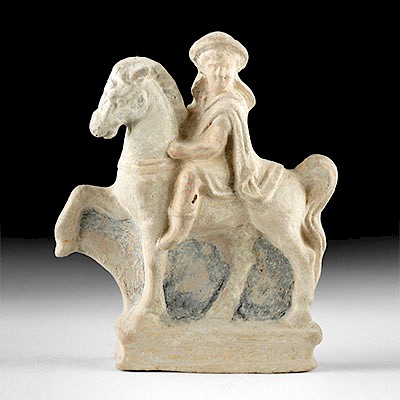Anatolian Bronze Bull Protome
Lot 74c
About Seller
Artemis Gallery
686 S Taylor Ave, Ste 106
Louisville, CO 80027
United States
Selling antiquities, ancient and ethnographic art online since 1993, Artemis Gallery specializes in Classical Antiquities (Egyptian, Greek, Roman, Near Eastern), Asian, Pre-Columbian, African / Tribal / Oceanographic art. Our extensive inventory includes pottery, stone, metal, wood, glass and textil...Read more
Estimate:
$2,800 - $4,200
Absentee vs Live bid
Two ways to bid:
- Leave a max absentee bid and the platform will bid on your behalf up to your maximum bid during the live auction.
- Bid live during the auction and your bids will be submitted real-time to the auctioneer.
Bid Increments
| Price | Bid Increment |
|---|---|
| $0 | $25 |
| $300 | $50 |
| $1,000 | $100 |
| $2,000 | $250 |
| $5,000 | $500 |
| $10,000 | $1,000 |
| $20,000 | $2,500 |
| $50,000 | $5,000 |
| $100,000 | $10,000 |
| $200,000 | $20,000 |
About Auction
By Artemis Gallery
May 9, 2019
Set Reminder
2019-05-09 10:00:00
2019-05-09 10:00:00
America/New_York
Bidsquare
Bidsquare : Ancient | Asian | Ethnographic
https://www.bidsquare.com/auctions/artemis-gallery/ancient-asian-ethnographic-4110
Featuring classical antiquities, ancient and ethnographic art from cultures encompassing the globe. All legally acquired, legal to sell. Satisfaction guaranteed. Convenient in-house shipping. Artemis Gallery info@artemisgallery.com
Featuring classical antiquities, ancient and ethnographic art from cultures encompassing the globe. All legally acquired, legal to sell. Satisfaction guaranteed. Convenient in-house shipping. Artemis Gallery info@artemisgallery.com
- Lot Description
Ancient Near East, Anatolian, ca. 2nd to 1st millennium BCE. A handsome cast bronze protome in the form of an elongated bull head and neck with a wide plate-like terminal for attachment. A heavy loop from the top of the neck allowed the object it was attached to to be hung. The bull's neck is muscular, the head with a long snout and slightly parted mouth. Deep wells for eye cavities indicate that it once had inlays, probably of precious metal or stone - a similar known example has lapis lazuli eyes, for example. Large horns curve backward from the top of the head, nearly meeting over the back. The back attachment plate has three large bronze pins through it, relics of its previous use, when it likely graced a vessel or small piece of furniture like a chest. Size: 2.6" W x 3" H (6.6 cm x 7.6 cm); 3.95" H (10 cm) on included custom stand.
Bucrania - bull heads - were very popular throughout the ancient world, celebrating the ritual religious practice of sacrificing bulls as well as the symbolism of the bull as a virile, powerful animal. In the eastern Mediterranean and the Levant, the bull symbolized the god of fertility from at least the 3rd millennium BCE, and bucrania appear on documents and models of sanctuaries.
Provenance: private East Coast, USA collection; ex-Richard Wagner collection, Cape Cod, Massachusetts, USA, acquired in the 1960s
All items legal to buy/sell under U.S. Statute covering cultural patrimony Code 2600, CHAPTER 14, and are guaranteed to be as described or your money back.
A Certificate of Authenticity will accompany all winning bids.
We ship worldwide and handle all shipping in-house for your convenience.
#143758Pretty mottled emerald green and turquoise patina on surface. Tips of both horns are lost, but otherwise in very nice condition with clear form.Condition
- Shipping Info
-
All shipping is handled in-house for your convenience. Your invoice from Artemis Gallery will include shipping calculation instructions. If in doubt, please inquire BEFORE bidding for estimated shipping costs for individual items.
-
- Buyer's Premium



 EUR
EUR CAD
CAD AUD
AUD GBP
GBP MXN
MXN HKD
HKD CNY
CNY MYR
MYR SEK
SEK SGD
SGD CHF
CHF THB
THB














